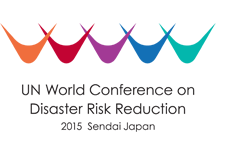The Sendai Framework for Disaster Risk Reduction was developed to guide efforts on disaster risk reduction in the period between 2015 and 2030. The framework was adopted during the Third World Conference on Disaster Risk Reduction, which was held in Sendai, Japan, from 14 to 18 March 2015. As in the case of its predecessor, the Hyogo Framework for Action (HFA), the Sendai Framework recognizes that Member States have the primary responsibility to prevent and reduce disaster risk.
The Sendai Framework: goal and expected outcome
Taking into consideration the fact that the HFA was instrumental in raising awareness on the need to focus on disaster risk reduction, in generating political commitment and in catalyzing actions by a wide range of stakeholders at all levels, Member States defined the goal of the Sendai Framework as follows:
"to prevent and reduce disaster risk through the implementation of integrated and inclusive economic, structural, legal, social, health, cultural, educational, environmental, technological, political, and institutional measures that prevent and reduce hazard exposure and vulnerability to disaster, increase preparedness for response and recovery and thus strengthen resilience."
For more information on the Sendai Framework, click here.
The Sendai Framework: priorities for action
Taking into consideration the experience gained through the implementation of the HFA, the Sendai Framework adopted the notion of priorities for action that were included in the HFA. The Sendai Framework includes four priorities:
- Understanding disaster risk
- Strengthening disaster risk governance to manage disaster risk
- Investing in disaster risk reduction for resilience
- Enhancing disaster preparedness for effective response and to "Build Back Better" in recovery, rehabilitation and reconstruction
Terminology, monitoring and evaluation for disaster risk reduction
The Open-ended Intergovernmental Expert Working Group on Indicators and Terminology is working on the update of the disaster risk reduction terminology, and on the indicators to monitor and evaluate progress in the implementation of the Sendai framework. For more information on the terminology, click here. For more information on the indicators, click here.
The Sendai Framework and the use of space-based information, and geospatial and space-based technologies
The Sendai Framework addresses explicitly the use of space-based information and technologies in Priority for Action 1: Understanding Risk. At the national and local levels the Sendai Framework calls for:
- The development of periodical updates and dissemination of location-based risk information, including risk maps, in an appropriate format, using, as applicable, geospatial information technology
- To promote real-time access to reliable data, make use of space and in-situ information, including geographic information systems, and use information and communications technology innovations to enhance measurement tools and the collection, analysis and dissemination of data
- To strengthen technical and scientific capacity to capitalize and consolidate existing knowledge and to develop and apply methodologies and models to assess disaster risks, vulnerabilities and exposure to all hazards
In a parallel fashion, the Sendai Frameworks calls on regional and international institutions to contribute to the implementation of the Framework through a variety of efforts including:
- To enhance the development and dissemination of science-based methodologies and tools to record and share disaster losses and disaggregated data and statistics, as well as to strengthen disaster risk modelling, assessment, mapping, monitoring and multi-hazard early warning systems
- To promote and enhance, through international cooperation, including technology transfer, access to and the sharing and use of non-sensitive data and information, as appropriate, communications and geospatial and space-based technologies and related services; maintain and strengthen in-situ and remotely-sensed Earth and climate observations
- Promote scientific research on disaster risk patterns, causes and effects; disseminate risk information with the best use of geospatial information technology
Fostering international cooperation - the role of UN-SPIDER
As a way to streamline regional and international cooperation, the Sendai Framework requests regional and international organizations to support countries and other stakeholders in the implementation of this framework, including the development of relevant sector policies and standards, monitoring mechanisms and the strengthening of capacities.
UN-SPIDER worked with other international and regional organizations, space agencies, and national civil protection agencies to launch during the Sendai Conference the Global Partnership Using Space-based Technology Applications for Disaster Risk Reduction (GP-STAR). This Partnership aims to foster the use of Earth observation and space-based technologies at all levels by strengthening existing mechanisms and contributing to a better integrated and wider use of such technologies in disaster risk reduction efforts worldwide. It also aims to develop and implement a plan of work for the next decade focusing on the use of space-based applications that will be tailored to the new framework.
During the United Nations/Germany International Conference on Earth Observation - Global Solutions for the Challenges of Sustainable Development in Societies at Risk and during the United Nations International Conference on Space-based Technologies for Disaster Risk Management: "A consolidating role in the implementation of the Sendai Framework for Disaster Risk Reduction: 2015-2030", UN-SPIDER and its partners conducted side events to advance on the implementation of GP-STAR.
In the coming years, UN-SPIDER will continue to work with its partners through GP-STAR as a way to contribute to the implementation of the Sendai Framework.

